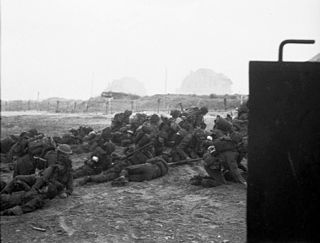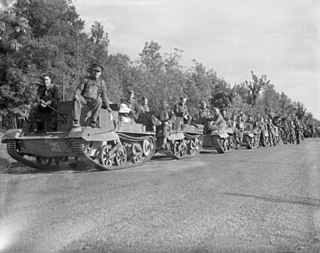
Sword, commonly known as Sword Beach, was the code name given to one of the five main landing areas along the Normandy coast during the initial assault phase, Operation Neptune, of Operation Overlord. The Allied invasion of German-occupied France commenced on 6 June 1944. Stretching 8 kilometres (5.0 mi) from Ouistreham to Saint-Aubin-sur-Mer, the beach proved to be the easternmost landing site of the invasion after the abortion of an attack on a sixth beach, code-named Band. Taking Sword was to be the responsibility of the British Army with sea transport, mine sweeping and a naval bombardment force provided by the British Royal Navy as well as elements from the Polish, Norwegian and other Allied navies.

Operation Compass was the first large British military operation of the Western Desert Campaign (1940–1943) during the Second World War. British metropolitan, Imperial and Commonwealth forces attacked the Italian and Libyan forces of the 10th Army in western Egypt and Cyrenaica, the eastern province of Libya, from December 1940 to February 1941.

The 1st Infantry Division (1ID) is a combined arms division of the United States Army, and is the oldest continuously serving division in the Regular Army. It has seen continuous service since its organization in 1917 during World War I. It was officially nicknamed "The Big Red One" after its shoulder patch and is also nicknamed "The Fighting First". The division has also received troop monikers of "The Big Dead One" and "The Bloody First" as puns on the respective officially sanctioned nicknames. It is currently based at Fort Riley, Kansas.

The 4th Infantry Division is a division of the United States Army based at Fort Carson, Colorado. It is composed of a division headquarters battalion, three brigade combat teams, a combat aviation brigade, a division sustainment brigade, and a division artillery.

The VII Army Corps of the United States Army was one of the two principal corps of the United States Army Europe during the Cold War. Activated in 1918 for World War I, it was reactivated for World War II and again during the Cold War. During both World War II and the Cold War it was subordinate to the Seventh Army, or USAREUR and was headquartered at Kelley Barracks in Stuttgart, West Germany, from 1951 until it was redeployed to the US after significant success in the Gulf War in 1991, then inactivated in 1992.

The 1st Airborne Division was an airborne infantry division of the British Army during the Second World War. The division was formed in late 1941 during the Second World War, after the British Prime Minister, Winston Churchill, demanded an airborne force, and was initially under command of Major-General Frederick A. M. "Boy" Browning. The division was one of two airborne divisions raised by the British Army during the war, with the other being the 6th Airborne Division, created in May 1943, using former units of the 1st Airborne Division.

The Norwegian Army is the land warfare service branch of the Norwegian Armed Forces. The Army is the oldest of the Norwegian service branches, established as a modern military organization under the command of the King of Norway in 1628. The Army participated in various continental wars during the 17th, 18th, and 19th centuries as well, both in Norway and abroad, especially in World War II (1939–1945). It constitutes part of the Norwegian military contribution as a charter member of the North Atlantic Treaty Organization (NATO) since 1949.

The 15th (Scottish) Infantry Division was an infantry division of the British Army that served during the Second World War. It was raised on 2 September 1939, the day before war was declared, as part of the Territorial Army (TA) and served in the United Kingdom and later North-West Europe from June 1944 to May 1945.

Operation Crusader was a military operation of the Western Desert campaign during World War II by the British Eighth Army against the Axis forces in North Africa commanded by Generalleutnant (Lieutenant-General) Erwin Rommel. The operation was intended to bypass Axis defences on the Egyptian–Libyan frontier, defeat the Axis armoured forces near Tobruk, raise the Siege of Tobruk and re-occupy Cyrenaica.

The 6th Infantry Division was an infantry division of the United States Army active in World War I, World War II, and the last years of the Cold War. Known as "Red Star", it was previously called the "Sight Seein' Sixth".

The Battle of Gazala, also the Gazala Offensive was fought near the village of Gazala during the Western Desert Campaign of the Second World War, west of the port of Tobruk in Libya, from 26 May to 21 June 1942. Axis troops of the Panzerarmee Afrika consisting of German and Italian units fought the British Eighth Army composed mainly of British Commonwealth, Indian and Free French troops.

The Land Component, historically and commonly still referred to as the Belgian Army, is the land branch of the Belgian Armed Forces. The King of the Belgians is the commander in chief. The current chief of staff of the Land Component is Major-General Jean-Pol Baugnée.

The 6th South African Armoured Division was the second armoured division of the South African Army and was formed during World War II. Established in early 1943, it was based on a nucleus of men from the former 1st South African Infantry Division who had returned to South Africa after the Second Battle of El Alamein in late 1942. The division was initially transferred to Egypt for training, after which it served in the Allied campaign in Italy during 1944 and 1945. In Italy, the division was initially deployed as part of the British Eighth Army, under command of Lieutenant-General Oliver Leese, and was then transferred to the U.S. Fifth Army, under Lieutenant General Mark W. Clark, for the remainder of the Italian Campaign. The division operated as a strongly reinforced division and was frequently used to spearhead the advance of the Corps and Army to which it was attached. They returned home after the end of the war in Italy and were disbanded in 1946. The division was also briefly active after the war from 1 July 1948 to 1 November 1949.

The Battle for Caen was a military engagement between the British Second Army and the German Panzergruppe West in the Second World War for control of the city of Caen and its vicinity during the Battle of Normandy.

The 50th (Northumbrian) Infantry Division was an infantry division of the British Army that saw distinguished service in the Second World War. Pre-war, the division was part of the Territorial Army (TA) and the two Ts in the divisional insignia represent the two main rivers of its recruitment area, namely the rivers Tyne, and Tees. The division served in almost all of the major engagements of the European War from 1940 until late 1944 and also served with distinction in North Africa, the Mediterranean and Middle East from mid-1941 to 1943. The 50th Division was one of two British divisions to land in Normandy on D-Day, 6 June 1944, where it landed on Gold Beach. Four men of the division were awarded the Victoria Cross during the war, more than any other division of the British Army during the Second World War.

The 15th Infantry Brigade, later 15 Brigade, was an infantry brigade of the British Army. It was part of the regular 5th Infantry Division during the First World War and Second World War, and was subsequently part of the 2nd Infantry Division in the north of the United Kingdom, with specific responsibility for the areas of North East England and Yorkshire and the Humber.

The 78th Infantry Division, also known as the Battleaxe Division, was an infantry division of the British Army, raised during the Second World War that fought, with great distinction, in Tunisia, Sicily and Italy from late 1942–1945.

The British Expeditionary Force (BEF) was the contingent of the British Army sent to France in 1939 after Britain and France declared war on Nazi Germany on 3 September, beginning the Second World War. The BEF existed from 2 September 1939 when the BEF GHQ was formed until 31 May 1940, when GHQ closed down and its troops reverted to the command of Home Forces. During the 1930s, the British government had planned to deter war by abolishing the Ten Year Rule and rearming from the very low level of readiness of the early 1930s. The bulk of the extra money went to the Royal Navy and the Royal Air Force but plans were made to re-equip a small number of Army and Territorial Army divisions for service overseas.

The Beauman Division was an improvised formation of the British Expeditionary Force (BEF) during the Second World War, which fought in France against the German 4th Army in June 1940, during Fall Rot, the final German offensive of the Battle of France.
V Battery Royal Horse Artillery was a battery of the Royal Horse Artillery. Formed in 1804, the battery took part in the Napoleonic Wars – notably the Peninsular War and Battle of Waterloo – before being placed into suspended animation in 1816 as part of the usual post-war reductions of the British Army.



















